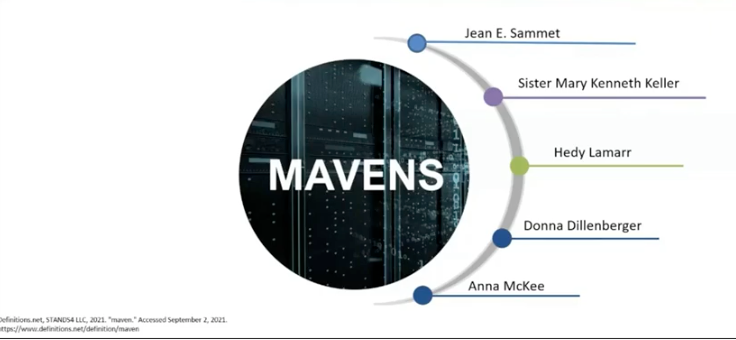There have been many amazing women who have made great contributions to the tech field through the years. You’ve probably heard about Ada Lovelace and Grace Hopper, among other pioneers.

But today you’ll learn about five mainframe mavens. With the help of Yvette LaMar, Director of the IBM Z Ecosystem at IBM, and Stacey Miller, Global Product Marketing Manager for SUSE Linux Enterprise Server for IBM Z and LinuxOne, Real Time, Geo Clustering and Global Services, – comarketing chairs of the Open Mainframe Project — you’ll meet five women who made amazing contributions to the mainframe.
Read more below about these amazing women and what makes them a maven or watch the video from the Open Mainframe Summit 2021.
Jean E. Sammet
Jean E. Sammet was a computer scientist who was born in New York in 1928. From an early age, she was interested in math.
She met plenty of challenges during her academic and professional lives. For instance, she couldn’t attend the Bronx High School of Science because they accepted only boys. Later on, she was denied a teaching job in high school. Eventually, she became an actuary, since that was one of the few jobs she could get as a woman.
In the 1950s, she started working with computers. Sammet worked for companies such as Sperry Rand, Sylvania, and IBM, where she created the FORMAC language. She was also involved with the creation of the highly influential COBOL programming language.
Sammet’s contributions were recognized with several awards, including the ACM’s Lovelace Award in 1989, the 2009 IEEE Computer Society Computer Pioneer Award, and the 2013 NCWIT Pioneer Award. She passed in 2017.
Sister Mary Kenneth Keller
Sister Mary Kenneth Keller was a computer scientist and Roman Catholic nun. She was born in 1913 and, among other things, is known for being the first woman in the US to earn a PhD in computer science.
In 1958, she started working at the Dartmouth National Science Foundation, where she helped in creating the BASIC programming language. Being an advocate for both the involvement of women in technology and the use of computers in education, she also founded the computer science department at Clarke College. Keller passed away in 1985.
Hedy Lamarr
Born at the onset of World War I in 1914, Hedy Lamarr had a broad array of interests from an early age. She had artistic interests and studied piano and ballet. But she also took a keen interest in learning about how things worked, and she would disassemble machines and toys to see how they operated.
At 23, she fled to the US to escape the Nazis because she was from a Jewish family. Her artistic talent and inclination led her to become a movie actor during the Golden Age of Hollywood. Despite having no STEM formal training, she didn’t let that stop her from learning and exploring.
Eventually, she met Howard Hughes, who was a big supporter of her desire to innovate. Hughes wanted to create faster planes, and Lamarr helped by sketching new designs for the planes’ wings by combining what she learned about the fastest birds and fishes by reading books on them.
During World War II, she was the co-inventor of frequency-hopping, an attempt to jam the communication of radio-guided torpedoes and set them off course. Such technology helped pave the way for modern communication technologies such as WiFi and Bluetooth.
She died in the year 2000.
Donna Dillenberger
Donna Dillenberger has had a distinguished career at IBM and currently serves there as an IBM Fellow. She was interested in STEM from a very early age, and she majored in math and computer science. She went to graduate school at Columbia University and later worked there as an adjunct professor.
Dillenberger focuses on machine learning, cloud security and availability, and enterprise systems. Among other things, she’s worked in machine learning models for the health care, retail, insurance, and finance industries. She’s also the author of many industry publications and holds many patents.
Anna McKee
Anna McKee graduated from the University of North Texas in 2019, obtaining a BS in business computer information systems and a BBA in decision sciences.
In 2017, she became the first woman to win the Master the Mainframe contest and then was the winner again in 2018. She currently works at IBM as a Db2 for z/OS systems programmer.
In Summary
There are many amazing women in STEM that could’ve been picked for this post, but the traits shared by all of them are common:
- All of these women faced challenges in their professional and academic lives, but persisted despite of them.
- All of them had a deep interest in science, technology, and learning about the workings of the world around them.
- Drive to mentor. They all share a drive to mentor, teach, and inspire.
This post was written by Carlos Schults. Carlos is a consultant and software engineer with experience in desktop, web, and mobile development. Though his primary language is C#, he has experience with a number of languages and platforms. His main interests include automated testing, version control, and code quality.